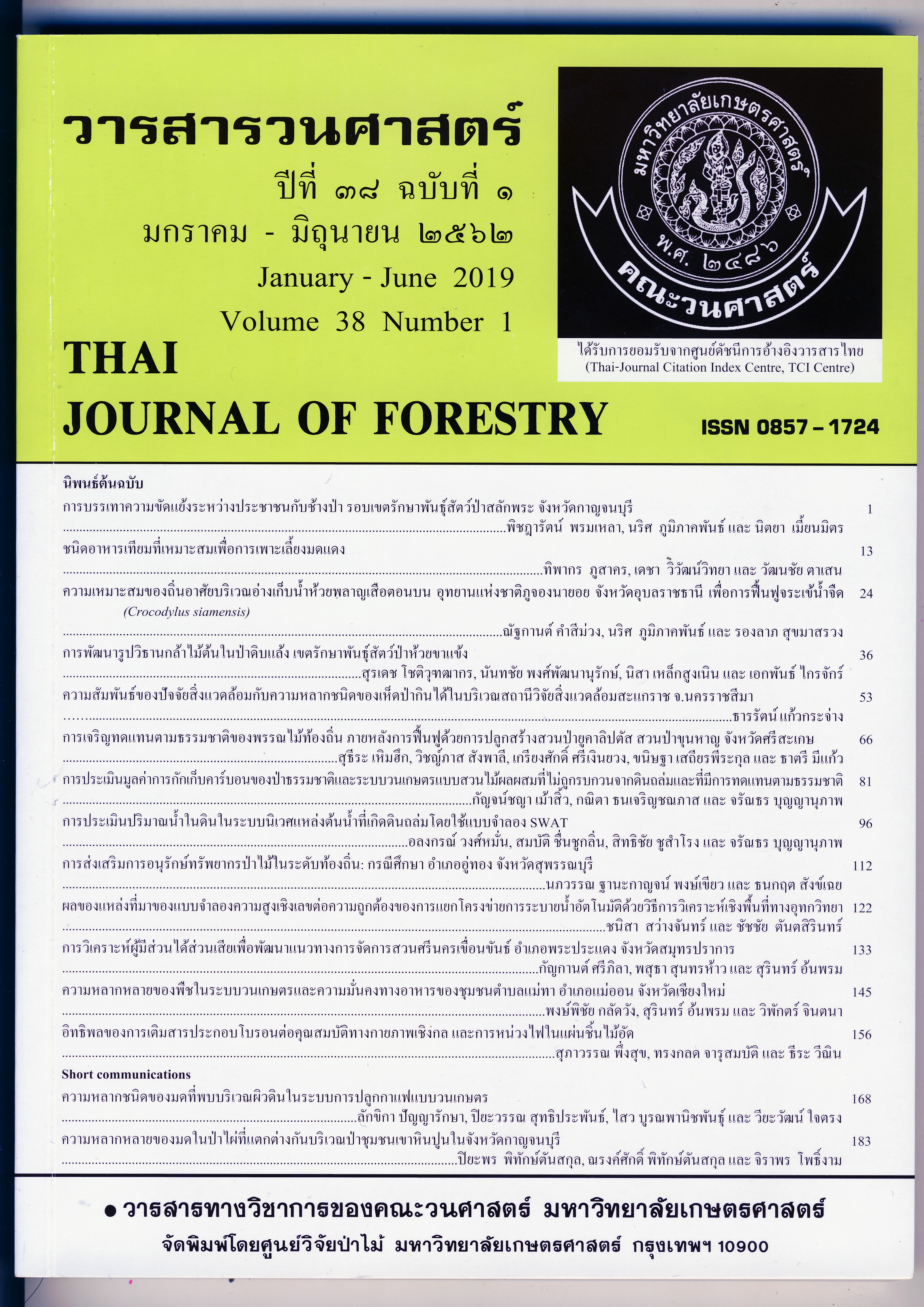การประเมินปริมาณน้ำในดินในระบบนิเวศแหล่งต้นน้ำที่เกิดดินถล่มโดยใช้แบบจำลอง SWAT
Main Article Content
บทคัดย่อ
น้ำในดินมีความสำคัญเป็นอย่างยิ่งสำหรับแหล่งต้นน้ำ เนื่องจากเป็นน้ำส่วนที่พืชใช้ประโยชน์ในการเจริญเติบโต ส่งผลต่อความอุดมสมบูรณ์และความยั่งยืนของระบบนิเวศ โดยพื้นที่ต้นน้ำของตำบลแม่พูล ซึ่งเคยเกิดเหตุการณ์ดินถล่มอย่างรุนแรงในปี 2549 อาจส่งผลกระทบต่อความสามารถในการเก็บกักน้ำของดิน การศึกษาครั้งนี้มีวัตถุประสงค์เพื่อประเมินปริมาณน้ำในดินของระบบนิเวศบริเวณแหล่งต้นน้ำภายใต้สถานการณ์ปกติและกระบวนการทดแทนตามธรรมชาติในปี 2559 (ภายหลังจากเกิดดินถล่มมาแล้ว 10 ปี) โดยใช้แบบจำลองอุทกวิทยา Soil and Water Assessment Tool (SWAT) ที่ปรับมาตรฐานของแบบจำลองน้ำในดินให้มีค่า R2 NSE และ PBIAS ที่สามารถยอมรับได้ โดยมีค่าเท่ากับ 0.58 0.48 และ 8.91 ตามลำดับ ซึ่งผลการวิเคราะห์จากแบบจำลองพบว่า ปริมาณน้ำในดินของเดือนตุลาคมมีปริมาณสูงสุดทั่วทั้งพื้นที่ โดยเฉพาะพื้นที่ความลาดชันต่ำ โดยมีปริมาณน้ำฝนที่ถูกเก็บกักไว้ในดินเท่ากับร้อยละ 5.15 หรือ 10.91 ล้านลูกบาศก์เมตร โดยมีความจุน้ำที่เป็นประโยชน์ รวมของทั้งลุ่มน้ำ (87.20 ตารางกิโลเมตร) เท่ากับ 39.55 ล้านลูกบาศก์เมตร ในขณะที่ปริมาณน้ำในดินเฉลี่ยตลอดปี 2559 ป่าเบญจพรรณผสมไผ่มีปริมาณสูงที่สุด (เฉลี่ย 180.82 มม.) รองลงมาได้แก่ สวนไม้ผลผสมแบบวนเกษตร (เฉลี่ย 174.01 มม.) ป่าเบญจพรรณผสมไผ่ที่เกิดดินถล่ม (เฉลี่ย 133.18 มม.) และสวนไม้ผลผสมแบบวนเกษตรที่เกิดดินถล่ม (เฉลี่ย 129.34 มม.) เมื่อเปรียบเทียบพื้นที่ปกติกับพื้นที่เกิดดินถล่มของทั้ง 2 ระบบนิเวศ แสดงให้เห็นว่า พื้นที่เกิดดินถล่มมีการเก็บกักน้ำในดินได้น้อยกว่าพื้นที่ปกติ หรือกล่าวได้ว่าการเกิดดินถล่มส่งผลให้ปริมาณน้ำในดินลดลง
Downloads
Article Details
ข้าพเจ้าและผู้เขียนร่วม (ถ้ามี) ขอรับรองว่า ต้นฉบับที่เสนอมานี้ยังไม่เคยได้รับการตีพิมพ์และไม่ได้อยู่ในระหว่างกระบวนการพิจารณาตีพิมพ์ลงในวารสารหรือสิ่งตีพิมพ์อื่นใด ข้าพเจ้าและผู้เขียนร่วม (ถ้ามี) ยอมรับหลักเกณฑ์และเงื่อนไขการพิจารณาต้นฉบับ ทั้งยินยอมให้กองบรรณาธิการมีสิทธิ์พิจารณาและตรวจแก้ต้นฉบับได้ตามที่เห็นสมควร พร้อมนี้ขอมอบลิขสิทธิ์ผลงานที่ได้รับการตีพิมพ์ให้แก่วารสารวนศาสตร์ คณะวนศาสตร์ มหาวิทยาลัยเกษตรศาสตร์ กรณีมีการฟ้องร้องเรื่องการละเมิดลิขสิทธิ์เกี่ยวกับภาพ กราฟ ข้อความส่วนใดส่วนหนึ่ง หรือ ข้อคิดเห็นที่ปรากฏในผลงาน ให้เป็นความรับผิดชอบของข้าพเจ้าและผู้เขียนร่วม (ถ้ามี) แต่เพียงฝ่ายเดียว และหากข้าพเจ้าและผู้เขียนร่วม (ถ้ามี) ประสงค์ถอนบทความในระหว่างกระบวนการพิจารณาของทางวารสาร ข้าพเจ้าและผู้เขียนร่วม (ถ้ามี) ยินดีรับผิดชอบค่าใช้จ่ายทั้งหมดที่เกิดขึ้นในกระบวนการพิจารณาบทความนั้น”
References
Bhatu, H. and H. Rank. 2017. Estimation the water balance component in Rangmati river basin using SWAT model. Trans Stellar 7: 547-554.
Blöschl, G., M. Sivapalan, H. Savenije, T. Wagener, A. Viglione. 2013. Runoff Prediction in Ungauged Basins: Synthesis Across Processes, Places and Scales. Cambridge University Press: Cambridge, UK.
Boonyanuphap, J. and P. Tonglem. 2011. Land Evaluation and Land Readjustment Guideline for Zoning of Agro-economic and Protected Areas in Steep Mountaionous. Complete Research Report. Thai Health Promotion
Foundation. (in Thai)
Deesaeng, B., C. Ornarsa, P. Witawaschugul. 2010. Soil Water Holding Capacity of Rayong Watershed. Department of National Parks, Wildlife and Plant Conservation. (in Thai)
Department of Mineral Resources. 2011. Risk map of community landslide, Uttaradit province.Complete report. Ministry of Natural Resources and Environment. Available source: http://www.dmr.go.th/download/north/Uttaradit_final.pdf, July 15, 2015. (in Thai)
Easton, Z.M. 2016. Soil and Soil Water Relationships. VCE publication BSE-194.
Havrylenko, S.B., J.M. Bodoque, R.Srinivasan, G.V.Zucarelli and P.Mercuri. 2016. Assessment of the soil water content in the Pampas region using SWAT. CATENA 137: 298-309.
Li M.X., Z.G. Ma and J.W. Du. Regional soil moisture simulation for Shaanxi Province using SWAT model validation and trend analysis. Sci China Earth Sci 53: 575–590.
Maepoon Tambon Administration Organization. 2015. General Information. Available source: http://www.maephun.org/modules.php?name=Downloads, June 28, 2015. (in Thai)
Moriasi, D.N., J.G. Arnold, M.W. Van Liew, R.L.Bingner, R.D. Harmel and T.L. Veith. 2013. Model evaluation guidelines for systematic quantification of accuracy in watershed simulations. Transactions of the ASABE
(3): 885-900.
Narasimhan, B. and R. Srinivasan. 2005. Development and evaluation of Soil Moisture Deficit Index(SMDI) and Evapotranspiration Deficit Index (ETDI) for agricultural drought monitoring.Agricultural and Forest Meteorology
: 69-88.
Ratneetoo, B. 2009. Organic fertilizer improves deteriorated soil. Princess of Naradhiwas University Journal 1 (2) : 1-16. (in Thai)
Sonkanha, W., S. Anusontpornperm, S. Thanachit, I. Kheoruenromne and T. Artchawakom. 2012. Soil characteristics under various types of forest in Sakaerat Environmental Research Station. Khon Kaen Agriculture Journal 40 : 7-18. (in Thai)
Suwanlertcharoen, T. 2011. Application of the SWAT Model to Evaluate Runoff and Suspended Sediment from a Small Watershed: A Case Study of Mae Phun Subwatershed, Laplae District, Uttaradit Province. M.S. Thesis,
Kasetsart Universtiy. (in Thai)
Tealnugutoom, B. 2005. Soil Science E–learning. Available source: http://elearning.nsru.ac.th/web_elearning/soil/lesson_4_3.php, June28, 2015. (in Thai)
Valdivia, C.P., B.C. Menun and D.W McMartin, 2017. Hydrological modeling of the pipestone creek watershed using theSoil Water Assessment Tool (SWAT): Assessing impacts of wet land drainage on hydrology. Journal of
Hydrology: Regional Studies 14: 109-129.
Wang D., M. Hejazi, X. Cai and A.J. Valocch. 2011. Climate change impact on meteorological, agricultural, and hydrological drought in central Illinois. Water Resour. Res 47: W09527.
Witawaschugul, P., S. Panuthai and P. Thitirojanawat. 2011. The Role of Forest Resources and Flooding Problems–Landslides. Watershed Conservation and Management Office. Department of National Parks, Wildlife and Plant Conservation. (in Thai)
Wongmun, A., K. Maosew and J. Boonyanuphap. 2017. Loss value of soil ecosystem services in the
upstream regions impacted by Landslide. Thai Journal of Forestry 36 (1) : 99-112. (in Thai)
Wongmun, A., K. Maosew and J. Boonyanuphap. 2017. Relationship of soil properties to soil water holding capacity in the upstream regions impacted by landslide. pp. 9-16, In The 2nd Naresuan Conference on Natural Resources, Geoinformation and Environment, Naresuan
University, Phitsanulok. (in Thai)
Wuttichaikitcharoen, P. and C. Sartun. 2013. Runoff estimation in Mae Chaem Basin using SWAT. pp. 1-5. In The 5rd EIT International Conference on Water Resources Engineering. 5-6 July 2013, Le Méridien Chiang Rai
Resort, Chiang Rai. (in Thai)

